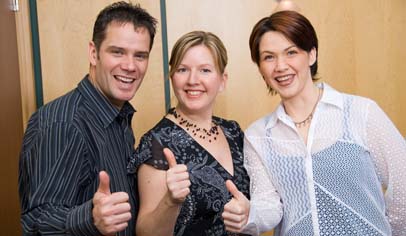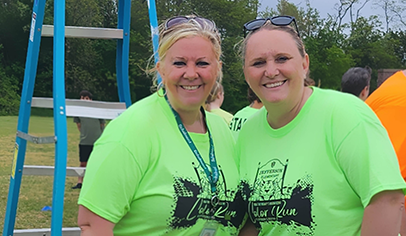“Harambe!” In Swahili, it means “a coming together.” In the large scheme of things, the word embodies the role of the leader. Far more than just a physical gathering, harambe is a coming together of spirit and mind, finding and standing on common ground to create synergy. Leaders facilitate harambe by helping groups articulate a vision for themselves that then provides focus for the group.
In the case of your PTO, the work of visioning may already have been accomplished in the past, and you have been handed a mission statement. Some PTOs have never gone through the process of formalizing what they are all about. Regardless of whether your group needs to revisit or to shape a statement of values and priorities for the first time, the process itself can inspire, energize, and help your PTO to make decisions about how they want to go about the business of achieving their vision day to day. That’s the power of harambe.
Developing a mission or vision statement is a process of discovering who you are as a group and why you have chosen to spend your collective energies in a PTO. As the word process implies, it doesn’t happen overnight. According to author Stephen Covey in The Seven Habits of Highly Effective People, we detect rather than invent our organizational mission. It comes from within and is an expression of the values, hopes, and dreams of the group. Also implicit is the fact that each PTO’s mission or vision statement will probably be a little different, even though they may share some basic interests, because each group is different.
To be truly effective and reflective of the group, the process must be inclusive, involving as much of the membership as possible. It cannot be an executive committee activity that leaves out the majority of the membership. People cannot be expected to own something they had no voice in creating. As businessman and author Max DePree states in his book Leadership Is an Art, “A belief that every person brings an offering to a group requires us to include as many people as possible. Including people, if we believe in the intrinsic value of their diversity, will be the only path open to us.” Harambe involves everyone!
The process begins when you ask group members to consider why they joined or are thinking of joining your group. What do we want for our children in this community? What are our hopes and our fears? What do we want our children’s school experience to be like? How do we see our parent group contributing to the achievement of our ideas about our children and their school?
This is the discovery phase. What ideas do group members share? What are the commonalities? Are there a few key ideas that people agree on? This phase can be accomplished with brainstorming in small groups or with the whole group. The goal is to get all ideas on the table. Now is not the time for detailed planning about how to get there. This is about the direction you will take on your journey. As the Cheshire cat pointed out to Alice in Lewis Carroll’s Alice in Wonderland, it doesn’t much matter how you get there if you don’t know where you’re going.
A Simple Exercise
Another idea for moving the process along comes from Dee Kelsey and Pam Plumb in their book Great Meetings! How to Facilitate Like a Pro. Entitled “Newspaper Article,” this activity can capture a group’s ideas about the desired future and build a belief and enthusiasm for how it could be. The activity goes like this:
Ask the group members to picture themselves and the PTO two years in the future. The group is running smoothly, accomplishing all its goals. A reporter from the local paper has done a feature article on your PTO. What do your members hope to see reported in the newspaper about them?
Let them brainstorm a list of ideas or comments that they would want included in the article. What does the article say? What are the key ideas it conveys? What activities does it report on? What kind of vocabulary does the reporter use to describe your PTO and its activities? What does the reporter say about the meeting he attended?
Collect the ideas and look for agreement (for example, you can use large newsprint paper and a larger group discussion) on the key themes, ideas, and vocabulary.
Next, ask people to work in pairs or small groups to come up with a great headline for the article based on the ideas that the group just agreed to.
Bring the whole group together and look for agreement on one or two headlines, or create a new one encompassing several of the ideas. This can be the beginning of the first draft of your mission or vision statement.
Taking the work accomplished in the first five steps, a smaller group could then be designated (appointees or volunteers) to draft a two or three sentence statement using the ideas, words, and phrases of the large group. The headlines may serve as the slogan or nutshell version of the statement that is used in public relations materials.
In fact once the statement is accepted by the larger group, maybe undergoing several drafts in between, it can guide decisions about what the PTO will or will not do.
Consider this example of a mission or vision statement: “The mission of ABC Elementary PTO is to develop a closer connection between school and home by encouraging parent involvement; enhance the educational experience by supporting academic and enrichment activities; and improve the environment at ABC Elementary by providing volunteer and financial support.”
This sentence forms a powerful declaration of the overarching goals of this parent group. It describes for whom and why the PTO exists, as well as providing focus for the future. The ABC PTO isn’t trying to do everything for everyone, and neither are you! Perhaps your group wants to enhance the educational opportunities available to students by sponsoring cultural events or by supplementing the school’s equipment budget or by simply involving more parents in the classroom. What is it that drives your particular group?
Discovering and articulating your mission is important work. It can unify, motivate, and even inspire your members. That’s the kind of “coming together” that harambe is all about. Focusing the attention of your group through harambe can mobilize you and your group not only to envision but actually to accomplish what you set out to do. You will know where you are going! And that makes it much easier to figure out how to get there.















